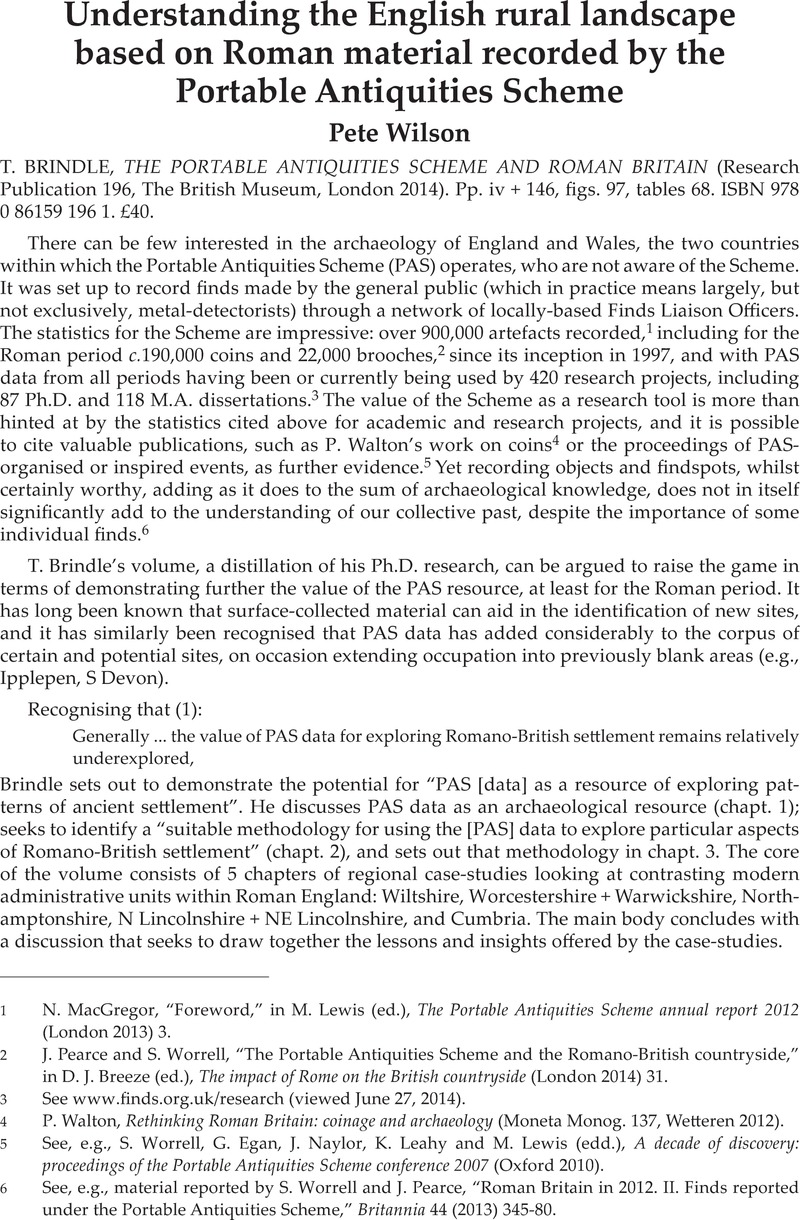No CrossRef data available.
Article contents
Understanding the English rural landscape based on Roman material recorded by the Portable Antiquities Scheme - T. BRINDLE, THE PORTABLE ANTIQUITIES SCHEME AND ROMAN BRITAIN (Research Publication 196, The British Museum, London 2014). Pp. iv + 146, figs. 97, tables 68. ISBN 978 0 86159 196 1. £40.
Published online by Cambridge University Press: 27 November 2014
Abstract

- Type
- Reviews
- Information
- Copyright
- Copyright © Journal of Roman Archaeology L.L.C. 2014
References
1 MacGregor, N., “Foreword,” in Lewis, M. (ed.), The Portable Antiquities Scheme annual report 2012 (London 2013) 3 Google Scholar.
2 Pearce, J. and Worrell, S., “The Portable Antiquities Scheme and the Romano-British countryside,” in Breeze, D. J. (ed.), The impact of Rome on the British countryside (London 2014) 31 Google Scholar.
3 See www.finds.org.uk/research (viewed June 27, 2014).
4 Walton, P., Rethinking Roman Britain: coinage and archaeology (Moneta Monog. 137, Wetteren 2012)Google Scholar.
5 See, e.g., Worrell, S., Egan, G., Naylor, J., Leahy, K. and Lewis, M. (edd.), A decade of discovery: proceedings of the Portable Antiquities Scheme conference 2007 (Oxford 2010)CrossRefGoogle Scholar.
6 See, e.g., material reported by Worrell, S. and Pearce, J., “Roman Britain in 2012. II. Finds reported under the Portable Antiquities Scheme,” Britannia 44 (2013) 345–80CrossRefGoogle Scholar.
7 For the scope and purpose of HERs, see http://www.english-heritage.org.uk/professional/protection/heritage-protection-reform/historic-environment-records/
8 Natural England is an Executive Non-departmental Public Body responsible for protecting and improving England’s natural environment.
9 Kernel density analyses are a statistical approach that allow inferences about populations, in this case densities of finds, to be made.
10 Now known as the English Heritage Archive (http://www.english-heritage.org.uk/professional/archives-and-collections/nmr/). While Brindle discusses the case-study areas in terms of PAS data and HER records in chapt. 3 (pp. 25-26), he also reviews the difficulties of using HER data to calculate the total number of Romano-British sites and for the purposes of his concluding discussion uses NMR data on Roman-period sites as a workable alternative.
11 The potential of such an approach under other circumstances has been demonstrated by Cool, H. E. M. and Baxter, M. J., “Exploring Romano-British finds assemblages,” OJA 21 (2002) 365–80Google Scholar (cited by Brindle).
12 In discussing the findspot “West Lavington 4 (WL/4)” Brindle (42) notes it as being recorded in the HER as a location that had “produced finds of ‘… such quantity and quality to suggest the site of a shrine or temple’ (Wiltshire HER no. 41765)”.
13 See, e.g., Shotter, D., “The Cumberland coast and the evidence of Roman coin loss,” in Wilson, R. J. A. and Caruana, I. D. (edd.), Romans on the Solway: essays in honour of Richard Bellhouse (CumbWest AntArchSoc, Extra Ser. 31, 2004) 195–204 Google Scholar.
14 See, e.g., Bidwell, P. and Hodgson, N., The Roman army in northern England (Kendal 2009) 33–34 Google Scholar.
15 See, e.g., A. Daubney, “The cult of Totatis: evidence for tribal identity in mid Roman Britain,” in Worrell et al. (supra n.5) 109-20.




